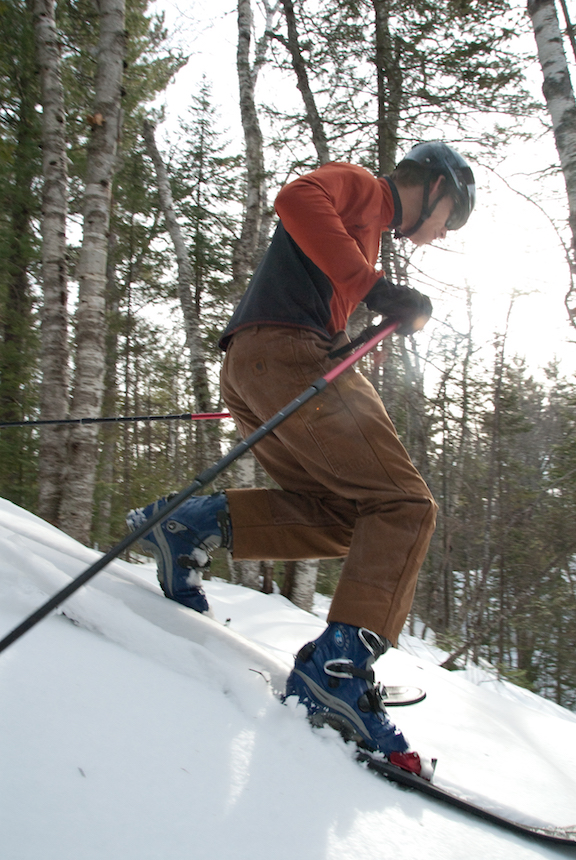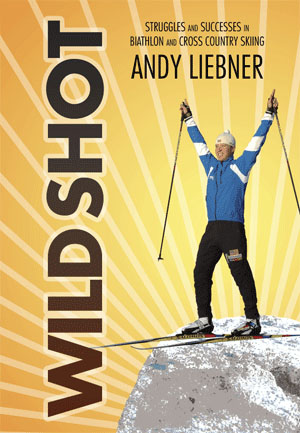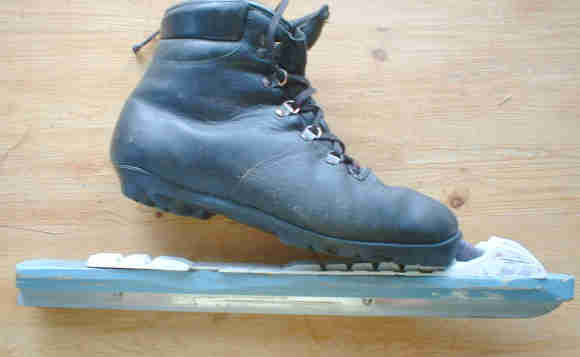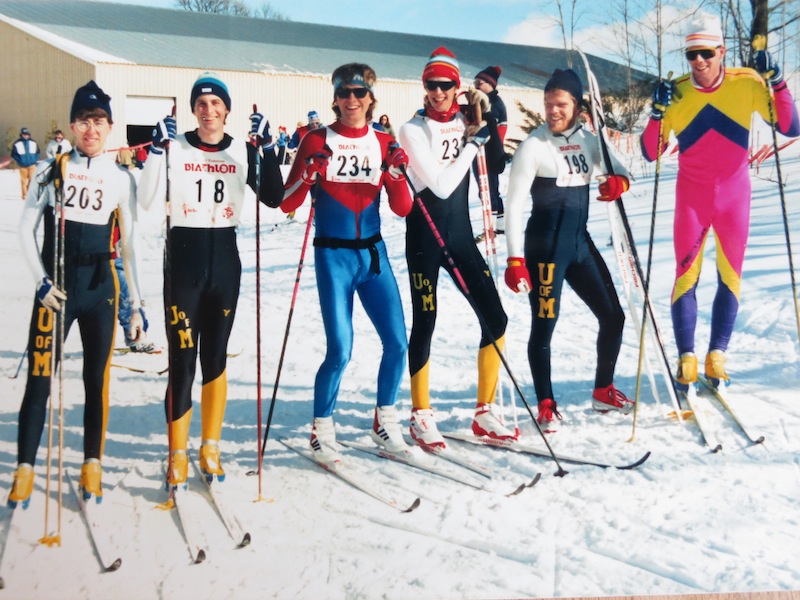More Photos Below!Gallery
(WOW, I just realized that I’d never posted this story to my website!)
Like many Midwesterners, I enjoy downhill skiing. Like most “Silent Sports” readers I really enjoy Nordic skiing. But for decades I never bothered to put the two together. Like some, I tended to put downhill in the non-‘silent’ category of thrill-sport. I was a longtime telemarker who lived in Colorado a few years where most of my free-heel action was lift-served, courtesy of the big motors and grooming machines. Well, I fondly remember the first time I “earned my turns”…
MY FIRST EARNED TURNS
Dave Jessop, a friend who lives near me here in mid-Michigan, had called a few times as I was getting ready to go to work, saying, “Hey, we just got some great powder, can you get away this morning? We have to hit it now before the sun warms it up. If you don’t have gear I can find you some.”
I thought he was a bit crazy with these surprise ideas. I already enjoyed skiing as much as I thought I could. I couldn’t just drop work on the spur of the moment to ski up and down a bit of backwoods when during lunch I could hit a local trail and stride around in bliss. The messy deep powder in the tracks would even be skied-in by then: nice and fast. Well, Dave had had good ideas before. So one morning when he called I said What the heck, I’ll go! He told me to hurry and that I’d find the ski gear in the back of his truck at the trailhead and to meet him and some pals at the secret spot a mile in the woods.
I trudged in on the heavy gear. It didn’t ski like I was used to, but I made it glide well enough. When I found the dudes at the hangout at the top of the slopes they were already grinning and covered in snow. I dropped my pack and glided with them to the brink and plunged into a world of skiing that I thought only existed in movies and on postcards of Colorado. I’d done a fair bit of telemarking and had skied powder so I relaxed into this wonderfully misplaced skiing. It was heaven! All it took was 10″ of fresh snow on a base of old snow. We regrouped at the bottom, hooting and hollering then skied up the valley, then up a few switchbacks to the top again and skied some more. I noticed beers strategically placed in the snow at the top of the climb. After an hour of exhilarating going down and exerting going up we took a break. My host pulled out of his pack a still-hot crockpot of venison stew swaddled in towels and we shared it around. Oh yeah!
As the sun swung onto us and slowed our turns a bit, I followed the gang as they set a new uptrack up a slope on the opposite side of the valley. It was still in the shade and so we kept on skiing on the still-perfect powder that they’d held in reserve.
The uphill skiing up wasn’t as different from my usual skiing as the striding had been. I could use good, relaxed form. We chugged up in unison, getting a little glide in our strides, chatting, laughing and picking new lines to run. They told me about how they came out in the fall and tossed aside the deadfall of the previous season to clear their lines. I knew how I liked my own autumn days taking care of local trails. I enjoyed watching the sun sparkle on the snow as we climbed. We were going slower, and it was steeper, than usual so the snow was closer and easier to marvel at. When we herringboned it was also at an easy pace since it was work enough. Still, a couple minutes and we were at the top, ready for more whoosh. Uphill and downhill were both restful and dynamic in their own ways.
I was able to relax and bounce down the fall-line, thanks to the amazing new skis I was using – wider, softer and shorter than any I’d used before. I watched one of the guys ski down the trunks of fallen trees, like we were in a terrain park. I watched another do beautiful “telellel” turns through trees so close together I couldn’t see between them from where I was. We put those snow-beers to good use. The dog flowed ahead of us like joyful smoke. I got home just after lunch.
The skiing was free, nearby, and with friends. I was totally won over. I’d just had a whole new dimension added to my winter world. Trail skiing goes through territory, while turn-skiing covers the territory.
Such perfect snowfalls arrive downstate here only on a few special mornings. But often enough! Their scarcity amplifies the specialness.
…And that’s how it happened.
Can you see why a Nordic skier might enjoy getting out in the woods for some free-spirited, free-cost freeheeling? And how the up’n’down of “earning your turns” might make sense for silent sports enthusiasts?
Any chance you’d like your gravity-sport to be FREE? And SUSTAINABLE? …To not require the huge overhead of lift motors and enormous grooming tractors and property management and access issues?
If you’re inclined to downhill turning, and you’d like to experience more of the woods, and you already enjoy uphill Nordic skiing, you’re almost there.
MIDWEST BACKCOUNTRY CULTURE
I’m a downstater. I decided to look into the BC scene for the rest of the state. So I called “up north” and asked my BC snow-junky pal, David Spieser, of Petoskey, what he thought about Midwest BC. David plays hooky with his friends whenever the powder pounds. He says, “It’s like an ice-skating party in the woods. There’s no worry about keeping up like on a trail. Everyone does their own thing, kinda near each other, yet still exploring, dropping down to home-base after each run. Some of our favorite places don’t have many trails, but they have miles of high-country slopes, like you’re more used to seeing out west, like the Chandler Hills public land, where your neck gets tired from looking up so much and where you might not hear the sound of a motor all day.”
A big hitch is that I think the typical Midwest idea is that resorts and grooming are for the gung-ho, while ungroomed skiing means hiking trails and golf courses for the casual. What’s more, backcountry skiing likely conjures up imagery of mountaineering in the Rockies, knife-edged ridges, big macho air, and avalanches.
Anyway, that’s how the ski mainstream presents it. The result is that Midwest or non-mountainous BC skiing is totally ignored! The BC magazines won’t even mention it. We’ve even dared them to.
George Gess is a salesperson from The Outfitter in Harbor Springs, MI, host of the annual last-day-of-the-season Telebration at Nub’s Nob (usually early April). He says he’s impressed by the recent growth in BC. “For something with no organized events and with small groups and even solo action afield, it does a good job of organizing itself. It spreads by word of mouth, from friend to friend, with everyone showing each other how it’s done.”
The mountains get all the PR, but how many people live there? Few. How many live around snowy rolling hills? Lots! “Earn your turns” certainly should apply to farmland hills and maple valleys.
Midwest gear shops also aren’t always hip to the potential of their own back yards. But ever-more of them are encouraging customers to get out there and find you some slope!
When you get down to it, in skiing, as in real estate, location is king. And the best location is where there’s snow. But terrain is critical, too. If it’s hilly you can have turns, if it’s mellow so you have your striding. But in the middle where most of us live we can have BOTH in a lot of our outings.
John “Radnord” Rutherford is a downstate resident and also multi-time “Nordic Man” of the Midwest Telefest in the Porkies in the western U.P. He’s famous for throwing in tele-turns on most any ski trail. Width really isn’t an issue. Just stride along and when you get to a downhill section just throw in the jump-turns! The Telefest lets skiers display skills from all disciplines in one weekend of fun events in a wide variety of terrain. Youngsters are nipping at Rad’s heels but every year he’s gungho to make the long drive to ski the Nordic medley. He says, “The Porkies is an example of the crossroads of the Nordic world. It has it all. Groomed slopes, groomed trails, backcountry peaks and a trail linking them together, all in a big state park.”
I freely admit the wonders of grooming. But if you want adventure, carefree fun, thrift and sustainability, make a beeline for the just-plain-snow. It’s a liberation movement for skiing!
Bill Thompson, co-owner of Down Wind Sports in Marquette and Houghton, and host of the Midwest Telefest (February, about 150 skiers), says, “BC is ‘silent sport’ all the way. A few long tele runs through the trees are a massive aerobic workout. Whenever there’s a big snow in this part of the state the tele skiers are off in the woods.”
THE BASICS OF BC
So why telemark? …Because it’s a way to ski downhill and to stride (back up the hill) using the same gear. This requires a free heels. You could take your skis off and trudge or snowshoe, but with our smaller hills it’s better to spend more time skiing and less time fussing. With a free heel you’re barely attached to your skis, so to improve stability the telemark turn was developed (in Telemark, Norway). By dropping low between skis that are spread out fore-and-aft and in an arced line, the skis both turn and behave.
How to learn it? That’s as easy as finding someone who knows! Wonderfully, today’s equipment is so easy to use that you can learn to tele in a day. Getting your entre’ to backcountry is just as easy, since it’ll probably be the same person. Or ask at a local outdoor gear shop or google your area. Once you find someone, are they your boot size? If so, it might be easier to borrow than to rent. Tele-people tend to have a “quiver,” just like track skiers. A certified instructor is best. Plan on a few sessions on groomed slopes. Supplement with friends, books, YouTube, as you like.
Ideally, for your first foray afield “earning your turns” go with a friend who knows the ropes.
I won’t get into the skiing how-to. It’s for you to discover. The bliss, freedom, camaraderie: there’s something for everyone. But you need to know what you’re getting into. A learning BC’er can easily transition from blue groomers to mellow, open wild slopes. But as soon as you drop into steep trees, you’re in double-black diamond country. Like Craig Dostie’s awesome “EarnYourTurns.com” website says in its subhead: “You’ll figure it out.” …Old school awesome! 🙂
Enn Poldmaa and Robin MacIntyre own the Bellevue Valley B&B just north of the Soo, and they have some steep terrain. They host the truly BC, no-lifts Snowflea Telefest (Feb. 23-24, 2013, 60 people), but there are guided outings most weekends. Enn says, “New skiers come and learn and in turn become the next group’s mentors. That way everyone gets a chance to be comic relief.” Robin chimed in: “Gravity gets you down the hills, levity gets you up. There’s so much snow that even though it’s steep here, when you fall you don’t get hurt. Oh, and there are a lot more women doing BC than you might think. Also, it’s about good food and live music. BC is holistic. I have to say that getting the human presence into the forest is critical for curtailing the industrial presence. Glade skiers need an intact canopy to hold the snow. We’ve shown the high recreation value of these unique 1000 public acres and saved it from low-value pulp logging. The Laurentians are the oldest mountains in the world and it’s the northern-most presence of oaks and hemlocks. It’s a special place to ski!”
(I can’t not share this great tip: Nest your runs closely together. The saying is either “Mind your margins,” or “Mine your margins,” or both. The point is to ski all your available snow. That way a few acres can give a small group a full day of untracked “virgin” powder.)
In the Midwest our slopes can be mellow, so what ya do is give a push at the top to get ’em moving. (OK, I can’t help but give some tips.) Schuss straight until your speed is up, then as long as you, gravity and skis work together to keep a nice turning-rhythm on the way down, you’re as good as gold. As they say, it’s not the miles-per-hour, but the smiles. Corny, but just you see!
After you regroup at the bottom of the run set your uptrack at an angle that your nowaxers or grip wax can handle without too much herringboning. Skins aren’t hardly part of the Midwest BC game, thankfully (you don’t want to be fiddling with gear for our quick laps).
You’re your own resort developer. You’re replicating the perks of resorts in a different worldclass venue: the real snow-world, maybe near where you live.
In BC no one is telling you where and how to ski. You scope out the lines you like best. Notice how the sun swings around. The sun makes Midwest snow heavy. Plan your day to follow the shade.
Then there’s the off season. If you find yourself skiing the same wild slopes year after year, you might want to do a little autumn woodswork clearing your lines. If it’s private land and you have permission, or it’s yours, do as you please. If it’s public, check the rules. Tossing aside deadfall is usually OK. You’ll learn you don’t need much space for superb turning. Do the minimum. …Leave no trace.
TECHNOLOGY BREAKTHROUGHS
Recent high-tech equipment changes have given ungroomed trail-skiing a total makeover. They’ve done the same for “earn your turns”!
Steve Barnett, one of the main guys behind modern telemark skiing, recently said in an awesome interview at Dostie’s site that he prefers a thrifty package probably considered too light by many: 68mm-wide, 190cm-long Madshus Glittertind skis and Salomon BC boots and bindings. That’s almost a trail rig, some might say. Well, Barnett certainly can do a lot with it. Gear is so much better than what they used “back in the day” that Barnett says he just stays impressed, and thinks going any bigger is close to overkill. Heck, we used to shred black double-diamond bumps on less!
(https://www.earnyourturns.com/3402/profile-steve-barnett-telemark-prophet/)
Before the modern era in telemark (“BMET”), BC skis were 70mm wide and an extreme ski was a 90mm repurposed downhill ski. These skis turn but require more skill, though they’re easy to tour on. Today’s wider, shaped, rockereed skis deliver easy turning anywhere — that’s not a bad wave to ride. It all depends on what you want.
Each step up in float and power reduces your range and striding. Even so, Gess of The Outfitter is excited about this year’s new Voile which has huge lift-served-type width plus rocker plus a nowax pattern, the “go biggest” BC ski to date. The pay-off in float joy and tolerance for conditions is worth it to many.
Don’t short-change on adjustable or other BC-specific poles for satisfying performance both up and down. Check the reviews as some have been sketchy, but most today are light and reliable. Some favor full-length striding poles that have grips or tape added part-way down — no risk of mechanism failure — use ’em long to ski up, grab the middles for the trip down (watch the eyes).
Erich Podjaske, of the Cross Country Ski Shop in Grayling, says they’re mostly a pro shop for groomed track skiing, but the BC side has taken off in the last 5 years. “We used to have 3 models, now we have 6. They run the full range of widths from metal-edged skis that still fit in a track up to skis that are as fat as lift-served but still have nowax patterns. My saying is that BC lets you turn your favorite summer spot into a favorite all year ’round. The better skiers can do it all with a pretty thin set. Now, full tele can be pricey, but we can get folks into a BC 65 package for both trails and some turning for under $400. Each step up in width from there means about another $50.”
One thing that keeps the full-on turns scene small is the high barrier to entry. Sure, it takes fitness, skill, and the right mindset. It also costs a lot. A package that is considered elite is also easy to learn on because of its width and stiffness; it’s almost like alpine skiing (and paralleling with it is easy) — and in lightweight BC format it can cost $1K. BC is a merger of thrifty trail sport with expensive lift-served performance, which needs to be even lighter for enjoyable backcountry roaming. Even with price-creep, though, don’t forget you’re now able to skip the lift-tickets and maybe the long drive and lodging.
Dave Ollila, who owns the Marquette Backcountry Ski Company, maker of the only all-plastic budget ski-snowshoe, says, “With BC you don’t have to obsess over skiing from lift-start to lift-close to cover an expensive lift ticket. You can grab an hour here or there on a wild slope near your house. It’s a new kind of skiing which is actually the original kind. For centuries people got around on short wide skis. It’s more like mt-biking or micro-adventuring. It’s ‘let’s see what’s over there.’ It’s like a jeep with two gears: easy or intense. It’s rugged, great for low-snow conditions, like skiing over roots or dirt. And at $189 our MBS is the cheapest way to go. This approach is shaking up the ski industry. I wouldn’t have it any other way.”
You can still build up a cheap kit by doing the old routine of mounting simple cable bindings onto secondhand downhill skis (kickwax ’em for the uptracks). Then you can beef up a lighter boot by buckling over it the upper “spat” of a secondhand alpine boot, as was also done back-in-the-day. It works!
The ski that sparked the recent revolution in Midwest BC was the venerable Karhu Guide, the first ski that was 109mm wide with a nowax pattern. (Now the Madshus Annum.) You could kick’n’glide ’em for a few miles then shred the trees with a grin. BC has since gotten even bigger, but it’s also improving on the narrower end, as Steve Barnett would remind us.
A great thing about Midwest BC is you won’t get avalanched and it’s a lot less far to fall. Still, consider some armor. Skiing wild means encounters with undersnow obstacles. Don’t forget your trees helmet! (I use my bike helmet.) As always, match gear to terrain. Arcteryx makes thin knee-shields. A few motocross shorts have minimalist hip and tailbone padding. Some use shin-guards and thin forearm football sleeves.
(2017 UPDATE: In recent years, tele skiing has suffered an upheaval as Alpine Touring has taken over. Tele gear makers have even closed shop in some cases. This is the heavy side and AT may well serve it better. Tele just got heavier and heavier until “poor” it disappeared into AT! Well, it’s still here, but it took a big hit in the mountains anyway. But the light BC side still remains the undisputed bailiwick of the free heel…)
ETIQUETTE
Another angle rears its head as friends, shops, and businesses spread the word and also work to control that same word: Secrecy. Wild slope skiing is like beach surfing. It’s like trout fishing. There’s getting in the know. And there’s turf.
Once while we were skiing a guy told me he thought there was too much traffic on our local slope. I said, “What’s too much?” He shot back: “YOU’re too much!” Yeah, two’s too many, sometimes. If you’re not quick and there’s been a nighttime snowfall, that same guy might be out there with a headlamp, skiing it up before any of his pals wake up. It’s dog eat dog, but he does do the most deadfall-tossing. Thankfully there are a lot of hills.
Yes, wild skiing has etiquette. If you think you’ve found a slope for you and your pals, look again. Is someone already skiing it? Have they put in hours rolling logs and tossing deadfall? When you show up, if it’s already “used up” consider how best to share. Before expecting much, wait until you’ve found your colleagues, talked it over, AND put in your share of brush-tidying. If it’s public land, anything goes. The DNR has no law against this kind of poaching. But what goes around…
I know skiers who will stand on the other side of a tree when someone is passing near. Nobody’s here!
Users on popular trails might obliviously ski past a hidden valley that has every inch skied after a good snowfall and yet they never think there might be good slope skiing within hundreds of miles.
Trail-skiing can support thousands of users in a day, but glade skiing in Midwest terrain is best in small groups.
***
So, head out with your pals and your picnic of choice. Do your own thing. Remember, that’s what all skiing used to be. A wider ski and more supportive boot is all you need to ski and turn in the wilds. If you want more, there’s a ski for that. It’s easy to find a set-up (or two) that lets you enjoy ALL your terrain.
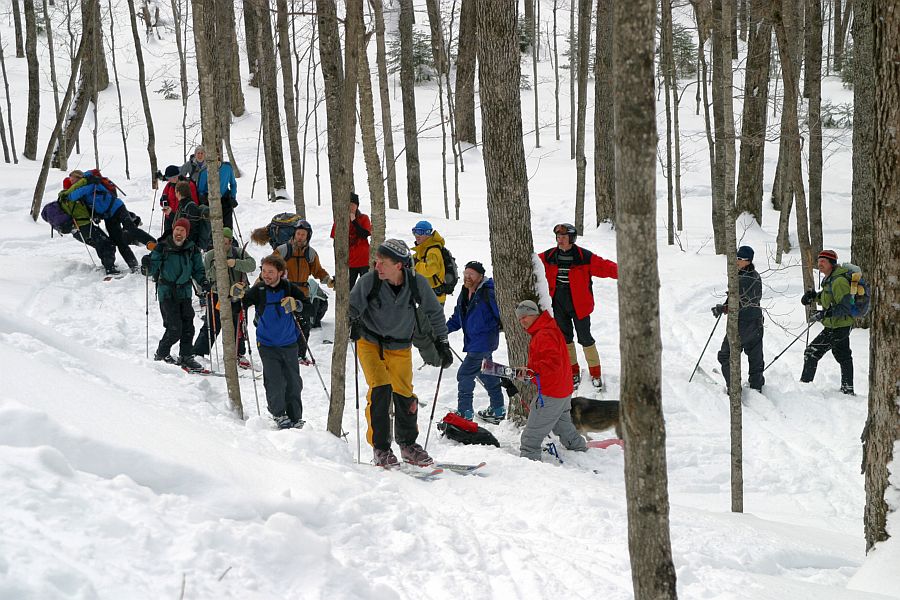
The mob at the Snowflea Telefest.
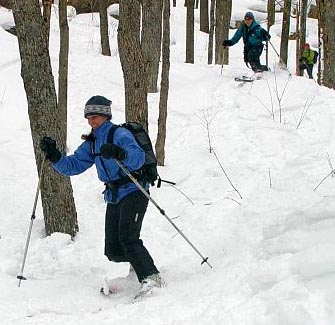
Snowflea shredding the hardwoods BC. Earn ’em!
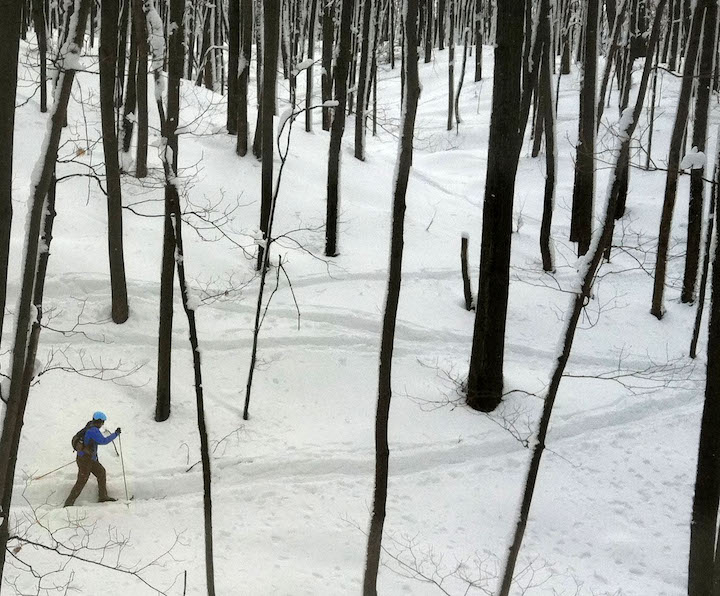
The uptrack in the magnificent Chandler Hills. (Location NE LP.)
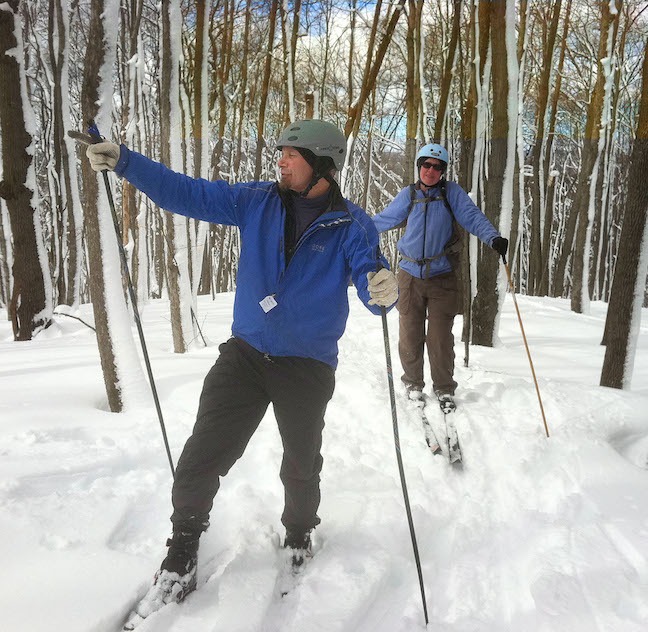
Jack and Cat, part of the gang skiing out to then up into the Chandler Hills: where next? so much to choose from!
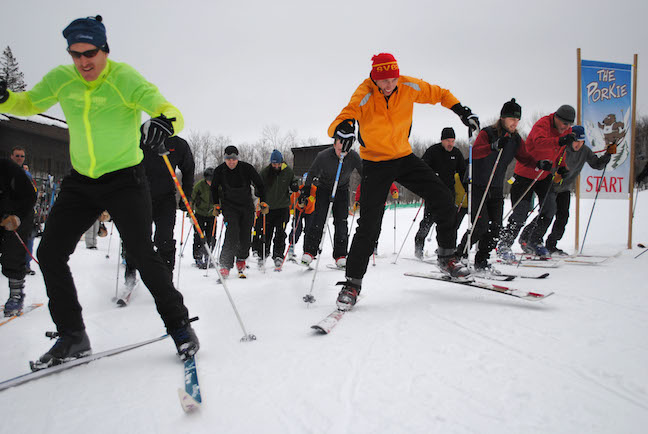
At the start of the Up Down Race at the Porkies Telefest.
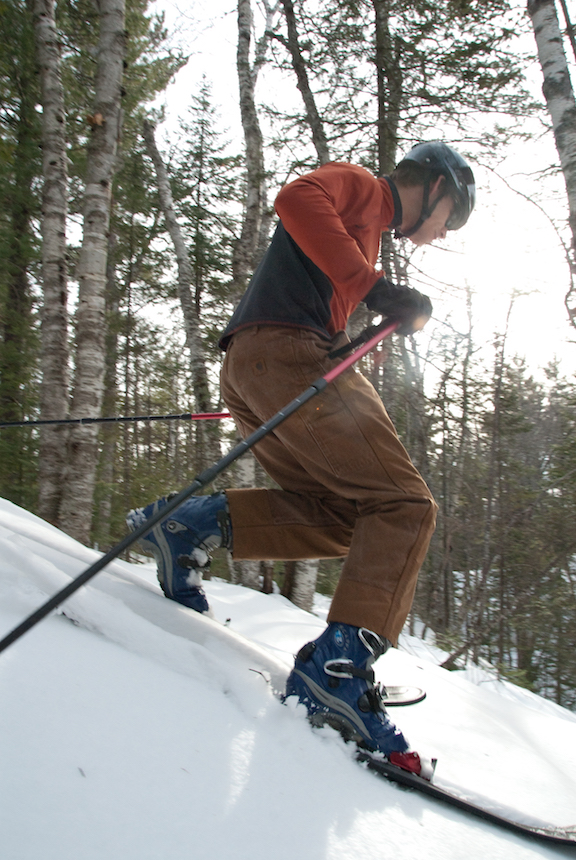
Using the namesake Marquette Backcountry skis to shred a steep watershed ravine near Marquette in Michigan’s UP. Use your uptrack to earn ’em!
